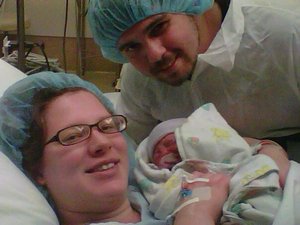When I found out I was pregnant only seven months after having a Cesarean section (C-section), I immediately knew I wanted to attempt a vaginal birth after Cesarean (VBAC).
I did everything I could to promote my chances of a successful VBAC – kept my weight gain under control, drank red raspberry leaf tea, saw the chiropractor frequently, and did light yoga.
The odds were already in my favor. The reason for my first C-section was unlikely to happen a second time. My third child had been breech, and her umbilical cord was around her neck twice. In addition, I had already experienced two successful vaginal births. As far as VBACs go, I was an ideal candidate, but I never even got to have my trial of labor.
When my water broke, there was no sign of contractions. I went to the hospital right away because my Group B Strep test had been positive. The midwife on call gave my nurse strict orders not to check my cervix unless I started having regular contractions. We wanted labor to start naturally, and she did not want to jeopardize that by increasing the risk of infection. It was decided that I would sleep until morning, and we would go from there.
Around 3:00 AM, I got up to use the restroom. When I returned to bed, the nurse became concerned and started adjusting the baby’s heart rate monitor. She asked if I had experienced a gush of amniotic fluid, and I told her I had. She called for assistance and had me lie on my side. Then she had me lie on my other side, return to the first side, and, finally, get on my hands on knees with my head down. I was also given an oxygen mask.
The OB/GYN on call asked me to sign a C-section consent “just in case.” I signed it because I was afraid for my baby. I signed it even though I was sure it meant I would not be having a VBAC. I was right; the doctor immediately announced that she wanted to do a C-section.
It turned out that Jameson, like his sister, had managed to get his cord wrapped around his neck twice. The cord was also very thin – thin enough that it took the nurses by surprise, judging by the way one asked, “Is that the umbilical cord? Is that the umbilical cord?” during the C-section. Apparently, when Jameson moved farther into the birth canal, it pinched the thin umbilical cord, causing fetal distress by limiting blood flow to him.
After all the signs had pointed to a successful VBAC, I did not even get to go into labor before my plans were turned upside down. It baffles and upsets me that the reason for my repeat C-section had nothing at all do with the risks associated with VBAC deliveries. I am very disappointed that I did not achieve my goal, but I am grateful to have a healthy child. If I had to do it again, I would still sign that consent because the health and safety of my child was and is more important to me than avoiding a repeat Cesarean.
Sources:
A VBAC Primer: Technical Issues for Midwives
Vaginal Birth after Cesarean






